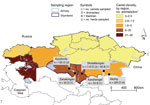Volume 22, Number 3—March 2016
Letter
Absence of Middle East Respiratory Syndrome Coronavirus in Camelids, Kazakhstan, 2015
Figure

Figure. Density of camelids in Kazakhstan (extracted from the Ministry of National Economy of the Republic of Kazakhstan Committee on Statistics, Department of Statistics; http://www.stat.gov.kz) and specimen collection for detection of Middle East respiratory syndrome virus, by species and region, 2015.
1These authors contributed equally to this article.
Page created: February 18, 2016
Page updated: February 18, 2016
Page reviewed: February 18, 2016
The conclusions, findings, and opinions expressed by authors contributing to this journal do not necessarily reflect the official position of the U.S. Department of Health and Human Services, the Public Health Service, the Centers for Disease Control and Prevention, or the authors' affiliated institutions. Use of trade names is for identification only and does not imply endorsement by any of the groups named above.